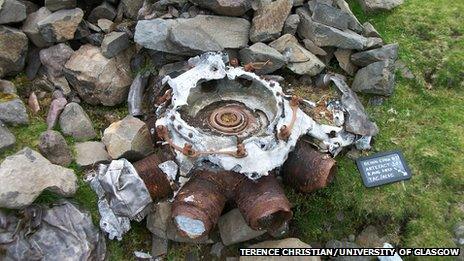'Error' in crashed World War II US bomber flight record
- Published

Part of an engine of the Flying Fortress that crashed on Skye 66 years ago
A US bomber which crashed in Scotland during World War II may not have been on the plane's officially recorded flightpath, according to an archaeologist.
All nine crew of the B-17G Flying Fortress were killed when the aircraft clipped cliffs and crashed in Trotternish, on Skye, on 3 March 1945.
Terence Christian, of the University of Glasgow, led an investigation at the site earlier this year.
He said there was evidence backing islanders' recollections of the crash.
Fresh from training, the crew were flying the B-17G bomber from the US via Iceland to RAF Valley in Wales.
They were to relieve another crew that had completed its allotted missions, but they crashed in bad weather on Beinn Edra in Trotternish.
Mr Christian, of Glasgow's Centre for Battlefield Archaeology, said the official record written after the incident had put the aircraft flying west to east over Skye towards the Scottish mainland.
However, after examining the wreck's "place in the landscape" and the spread and direction of the wreckage, he said there was evidence to support eyewitness accounts of the bomber flying east to west, as the crew tried to get their bearings.
This flightpath would have taken the bomber over, or near, Eilean Flodigarry, a small isle off the west coast of Skye.
Among those who saw the Flying Fortress was a member of a family Mr Christian and his team met with in Uig, which lies close to the crash site.
The man was a boy when the crash happened and his father was one of the first on the scene and tried to go to the aid of the aircraft's crew.
Mr Christian said the fact the plane was travelling in the wrong direction before impact underlined how disorientating the weather conditions were.
The archaeologist and his team became lost themselves in thick mist on their first attempt to examine the wreckage.
With visibility down to a few metres they had to navigate themselves away from the top of Beinn Edra's cliffs using a map and compass.
The team returned in better weather and were able to assess the wreckage.
Mr Christian said: "What local people remember is that the plane came over Eilean Flodigarry travelling east to west before the impact.
"What we could see from the larger parts of the wreck and their place in the landscape backed the local oral history.
"It appears those writing the official record went with their gut instinct that it was flying west to east before belly landing on top of the cliffs."
Mr Christian sought permission from the Ministry of Defence (MoD) and worked with crewmen's families before carrying out the investigation.
He said the nine who died were skilled airmen who had taken the aircraft below cloud level to try to get their bearings and had just been unlucky.
The crew manifest lists the crew members as pilot Second Lt Paul M Overfield Jr, co-pilot Second Lt Leroy E Cagle, navigator Second Lt Charles K Jeanblanc, radio operator Cpl Arthur W Kopp Jr, engineer Cpl Harold D Blue and gunners Cpl John H Vaughan, Cpl Harold A Fahselt, Cpl George S Aldrich and Cpl Carter D Wilkinson.

The bomber crashed on Beinn Edra in bad weather
Eight were killed instantly and one was thrown clear and died of his injuries.
Their bodies were later repatriated.
Mr Christian's research aims to develop new aircraft archaeology-specific methodology as a means to record and manage World War II crash sites.
Other sites he will look at include a B-17 used by the RAF for meteorological work that came down near Wick and an excavation of a B-17 on Arran.
He will also examine the sites of two crashed Mosquitoes in Dumfries and Galloway.
The Skye crash site spreads to an area of about 450m by 450m (1,476ft). Wreckage includes an engine.
When the archaeologists arrived at the site this summer they spotted a ram butting a piece of the bomber's armoured plating.
Mr Christian said: "There are many crash sites in Scotland and the UK where the crews were not in action.
"But their sacrifice should not be ignored. They still gave their lives after signing up because of a national cause, or because they chose to.
"These wreck sites should be treated with respect as the pieces of wreckage are the memorials to the crews."
He added: "People should also avoid picking up any pieces of wreckage as that can lead to damage to the part of it protected from the elements and moving pieces harms the integrity of the crash site."
- Published26 April 2011